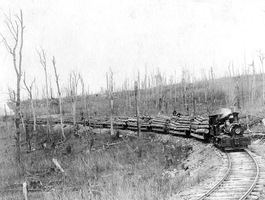 | Back to e-WV
| Back to e-WV
 The West Virginia Encyclopedia
The West Virginia Encyclopedia
 | Back to e-WV
| Back to e-WV
 The West Virginia Encyclopedia
The West Virginia Encyclopedia

Two-thirds of West Virginia was still covered by ancient growth forest in 1880 on the eve of the industrial transition, but during the next 40 years the state was almost completely denuded.
One of America’s first industries, water-powered sawmills, multiplied with the population along colonial waterways and expanded with the westward movement into the receding frontier. Steam-powered circular sawmills replaced water-powered mills during the 19th century, and at the turn of the 20th century huge steam and electric-powered band mills, each capable of cutting thousands of acres per year, were built by the larger companies. Railroads greatly facilitated the removal of the virgin forest by providing the transportation for hauling heavy equipment into the woods and by shipping lumber in volume to the national markets.
In West Virginia as elsewhere, the lumbermen’s philosophy of ‘‘cut out and get out’’ ensured the rapid depletion of the forest. Large capital investment resulted in heavy debt which in turn demanded maximum and constant production if lumber companies were to remain solvent. The wealth of the virgin forest invited over-expansion, and lumbermen borrowed capital which had to be repaid. Often it was cheaper for big mills to continue cutting timber even at a loss than to stop production when prices inevitably declined from over-development and cutthroat competition. Economic conditions, improved milling technology, and the absence of an American ethic of conservation all conspired to hasten the deforestation of West Virginia.
From the beginning, farmers depended on the forest to supply building materials and the logs they floated to downstream mills to sell for cash. Expansion of the logging industry came slowly during the 19th century, but then accelerated to a crescendo between 1880 and 1920. During this period even the state’s most remote mountain counties were integrated into the national markets by the 4,000 miles of railroad track that had been laid.
Cutting the timber resulted in major changes not just to the landscape but to all aspects of life. Towns sprouted up like wildflowers, new legislation and case law buttressed industrial expansion, and agriculture began its long decline. Many farmers thought that the country would be opened for farming once the timber was cut, but the soil was generally too poor for commercial farming, and farmers were unable to compete with their Midwestern counterparts in the markets to which they were now connected by the railroads.
The decline in agriculture was accelerated by the environmental disaster that deforestation left in its wake. Forest fires repeatedly swept over the land, 710 of them burning 1.7 million acres in 1908 alone. The streams became polluted and devoid of life, while floods ravaged the valleys below, and erosion washed away topsoil into the streams, silting up navigable watercourses. To save the inland waterways, the federal government embarked on a plan to protect the Ohio and Potomac watersheds by establishing the Monongahela National Forest in 1920. By then entire ecological systems had been destroyed. A more widespread conservation movement began in the 1930s.
Once the mountains had been skinned of their forest, the lumber companies closed their operations and moved on to greener country in the South and West. Without lumber the railroads soon pulled up their tracks and withdrew from the mountains as well, leaving a displaced people and a degraded land to confront the Great Depression.
e-WV presents West Virginia Public Broadcasting on Ancient Forests
Written by Ronald L. Lewis
Eller, Ronald D. Miners, Millhands, and Mountaineers. Knoxville: University of Tennessee Press, 1982.
Lewis, Ronald L. Transforming the Appalachian Countryside. Chapel Hill: University of North Carolina Press, 1998.